Intel Confirms Some Details about 28-Core 5 GHz Demonstration
by Ian Cutress on June 8, 2018 12:45 AM EST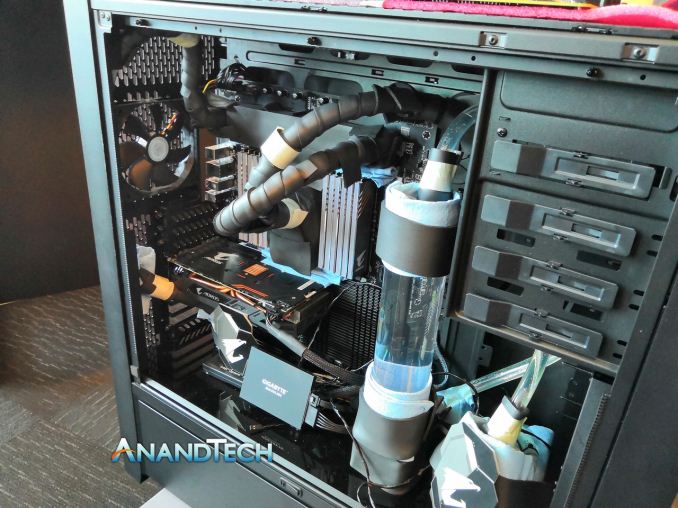
When Intel demonstrated its 28-core system running at 5 GHz at the Computex 2018 keynote this week, there were many questions surrounding the hardware and what was required in order to showcase this. The presentation was relatively light on details – perhaps purposefully so – however Intel SVP and GM Gregory Bryant stated that the processor was set to come out during Q4.
You can read our coverage about the launch in this article:
Intel's 28-Core 5 GHz CPU: Coming in Q4: Link
We also had a chance to examine the system that the demo was run on, in particular the cooling method and the motherboard. We have this article here:
We Got A Sneak Peek on Intel's 28-Core: All You Need to Know: Link
Now there were obviously a lot of questions about the demonstration. Was the CPU overclocked? What cooling was used? What platform did it run on? Which motherboard did it run on? What architecture is being used? What process node? What was the power consumption? We met with an Intel representative yesterday who answered some of these questions.
Was the CPU Overclocked?
The Intel representative did confirm the CPU was overclocked. We were told that on stage the presenter was actually meant to clarify that the system was overclocked, however the specific wording was not stated as it had been prepared.
There are many ways to interpret this – we did tell Intel that we had hoped that the presenter would have spent more time on stage talking about the system in play, discussing the platform it was running on, and making the system more ‘bright’ inside so that people could determine several things from photographs, rather than it looking almost like a black box with hidden pipes. Our commentary was taken on board by the Intel team we spoke to.
What cooling was used?
Intel confirmed that a water chiller was used, which we saw in our system demo examination the day after the presentation. We were told that it was not intended to showcase the cooling on the stage due to time constraints, to which we responded that Intel’s implementation of pre-overclocked systems in the past are typically accompainied a discussion on the pre-overclocked nature and the cooling used in the past, yet this presentation did not have this.
In our pre-briefing it was stated that this was a technical showcase (the bit where it was stated that this was coming to market was a bit of a shock if we’re honest), however this was not communicated as well as it should have been on stage. Again, Intel stated that they were taking our comments on board.
What Platform Did It Run On?
Intel did not answer this platform directly, however it was clear that the CPU was aimed at the LGA3647 server-based socket given from our examination of the demo system. It was unclear how Intel was going to promote this as an extreme workstation-type system, however Intel did note that they expect only a select market to be interested in this type of processor: a niche of a niche.
Intel know very well that there is a crowd of its customers that will buy performance at any price, and it doesn’t take a leap to suggest that this part is for those users.
Which Motherboard Did It Run On?
At the time of the presentation, Intel stated that they had partnered with both ASUS and GIGABYTE to create systems around the new 28-core product, however they didn’t state which system the 5 GHz demo was run on. We heard from both of the motherboard companies that it was actually the GIGABYTE system that hit 5 GHz, however it was noted that Intel did not explicitly call out the partner that hit the milestone. GIGABYTE confirmed that they certainly hit 5 GHz; we have yet to speak to ASUS on the matter. We do know that Intel quickly removed the CPUs in the demo systems from ASUS and GIGABYTE the next day with little notice. In between those times we have seen videos published from LinusTechTips (on ASUS) and Paul’s Hardware (on GIGABYTE) showing a Cinebench run.
What Architecture Did It Run? What Process Node?
The only item that Intel would confirm here is that the 28-core processor is built on one of its 14nm nodes. For anyone thinking it was a 10nm node, this confirms that it was not, however it does not say much more; Intel is purposefully keeping its cards close to its chest on this one. The smart money seems to be that the chip is likely to at least be based on the Skylake-X processors, like the 28-core Xeon Platinum 8176 or Xeon Platinum 8180, rather than the future Cascade Lake platform, however Intel has also promised that the consumer version of Cascade Lake-X will be coming by the end of the year.
Speaking with the motherboard vendors and OEMs in general about Intel’s HEDT plans is a tricky business, but most seem to be focused on their current X299 motherboards right now rather than a series of X299 refreshes that normally accompany an HEDT update.
What was the Power Consumption?
Again, this was one of the items that Intel wants to keep close to its chest. After confirming that the 5.0 GHz number was an overclocked value, it does mean that the base TDP for a ‘retail’ processor will be much lower, as the chip will be running at much lower clocks. The Xeon Platinum 8180 has a base frequency of 2.5 GHz and a turbo of 3.8 GHz for a TDP of 205W (TDP being defined at the base frequency only), and we know that the LGA3647 socket by its Intel reference design was made for chips up to 265W, so the frequency of the 28-core part shown by Intel for extreme workstations is only likely to be a +100-400 MHz more at most.
Interestingly enough, Intel states the maximum operating temperature of the 8180 at 205W TDP as 84C case temperature and 98C DTS, which sounds slightly higher than its standard settings for enterprise chips. It would mean that this new 28-core, if it comes out at 265W TDP, is likely to be a super high bin of the part. Of course, this will come with a higher cost.
One of the interesting numbers to come out of the initial announcement were that overclockers were seeing 1000W power draw for an 18-core Core i9-7980XE at 4.9 GHz, so one would assume that a 28-core at 5.0 GHz would be more. We know that the demo that achieved 5.0 GHz was using a Hailea water chiller capable of 1770W of cooling, and the system being used had a 1600W power supply with a low power graphics card. That gives us a good idea for low-bound and high-bound. However Intel would not help narrow down our estimates.
What Intel Needs To Do
One of our points to Intel was that the story around the 28-core announcement was not ideally communicated. (ed: this is an understatement) The systems holding the machines were not very well described in what they were doing, leading to massive amounts of speculation. The insides of the systems were dimly lit, and the cooling apparatus was hidden. Intel could have made the story around the parts be about the technology behind the demonstration, and the ability to push the limits of the hardware to new heights, however, even if the word ‘overclocked’ was accidentally not said on stage, these part of the story was not explained. Not in the ‘it wasn’t explained well’, it just wasn’t explained period. The best thing Intel can do at this point is to grab the story by the horns, and show that this is a passion project: let the readers and reviewers know about the platform, about the implementation (even if new explicit information isn’t shared), and that it actually takes a good amount of engineering prowess and skill to put on a 28-core, 5.0 GHz demonstration.
As it stands, we await further information.
| Want to keep up to date with all of our Computex 2018 Coverage? | ||||||
 Laptops |
 Hardware |
 Chips |
||||
| Follow AnandTech's breaking news here! | ||||||


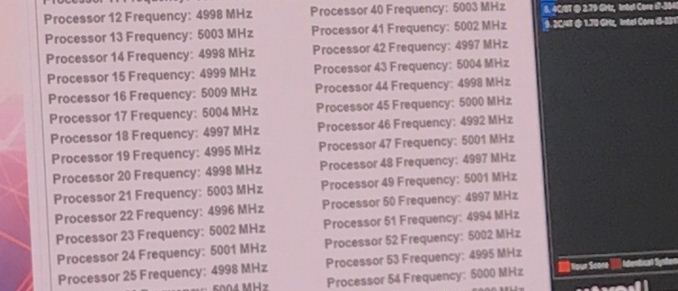
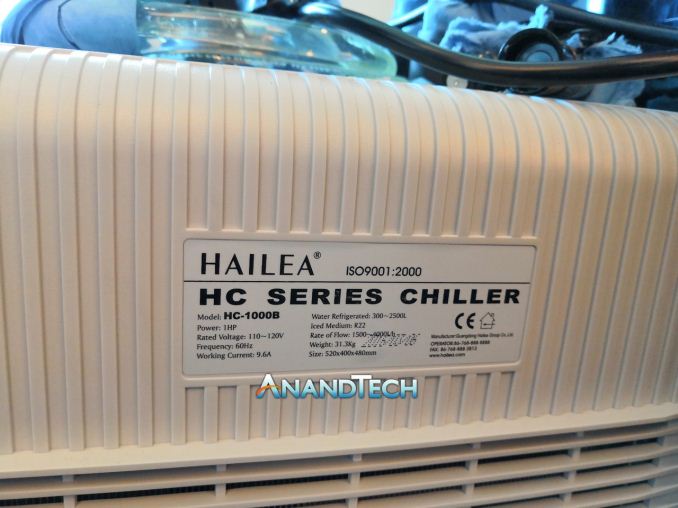
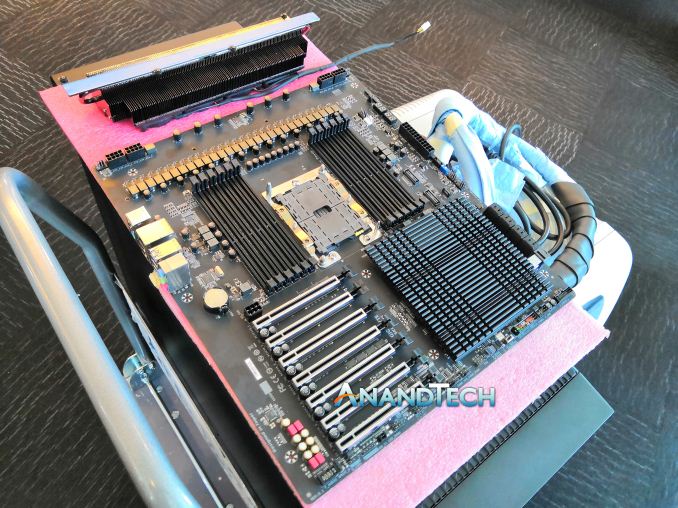
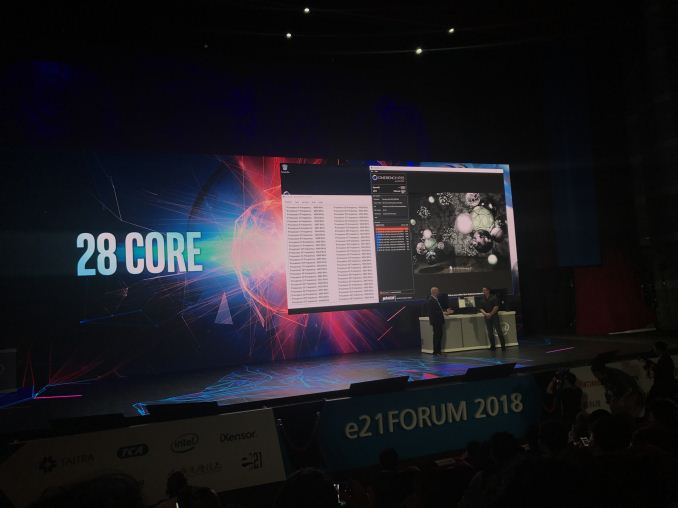








145 Comments
View All Comments
BambiBoom - Saturday, June 9, 2018 - link
Ananderators,Anyone looking critically at the photos originally released of the 28C@5GHz system should recognize that they're looking at a trade show demonstration of an engineering sample processor on a prototype proprietary motherboard, cooled by a custom liquid system connected by large pipes that run to an external unit underneath on a cart. How is this deceptive or misleading- a "scam"?
The announcement was that a 28-core CPU ran all cores at 5GHz. It did that. When a competitive overclocker runs an i7-7700K at 8.5GHz for .262 seconds, with two cores and hyperthreading disabled, and there is a photo of a cobbled-together tray of liquid Nitrogen sitting on the CPU, is that a trick, "fake news"?
Anyway, while this is an note-worthy achievement, is it anymore than a curiosity to the average gamer or workstation user? Look at the specifications for the nearest Intel offering , the Xeon Platinum 8180:
https://ark.intel.com/products/120496/Intel-Xeon-P...
> and scroll down to the line reading, " Recommended Customer Price $10009.00 - $10015.00 "
Quite funny to see there a $6 range on a $10,000 price. Watch for the spectacular one-day-only Black Friday sale at $9,999.99!
This was of course a clickbait demonstration at a trade show, but not deceptive and not a plot to trick WoW fans to impulsively slam a $10,000- or will it be $12,000? CPU on their credit card and then sit next to the post box panting for delivery.
The current core mania surprises me anyway. There are few applications multi-threaded efficiently beyond 5-6 cores. My next CPU will be an 8-core @ 5GHz - not 28-core. And I could do that tomorrow.
I daily, chant my mantra: "single thread, single thread, single thread."
BambiBoom
(Xeon E5-1680 v2 8C@4.3Ghz)
close - Saturday, June 9, 2018 - link
It's a scam because Intel hid all of those details from the audience (as much as they could). Intel did their best to suggest that it's a "standard" CPU that will be launched as a 28 core, 5GHz part later this year and then did absolutely nothing to correct the "misunderstanding". This is the textbook definition of a scam dear commenter that registered on Anandtech just to post this ;).But the main issue here isn't that Intel did it since it should be expected (as already proven) that Intel will stop at nothing to discredit and sabotage their competition, by illegal or immoral means. The problem is that both Ryan Smith and Ian Cutress of Anandtech took the bait, reported false information on the website, and when they discovered the deception instead of nailing Intel to the cross they played it down and all but defended Intel in this article because they "care too much" and they are "professionals".
This makes the Editor in Chief and the Senior Editor for AT look unprofessional, inexperienced, gullible, or biased (by any means). Or a combination of the above. There is no other explanation why a person in this position would allow himself to be so easily tricked and then to react so softly that it's embarrassing to look at.
BambiBoom - Saturday, June 9, 2018 - link
close,I'm fully prepared to admit I've missed some important details and agree with several of your comments. On the other hand, I make a lot of judgements based on what I see, rather than the commercial wordfeed. In this example, the photos all screamed Intel panic- thanks muchly AMD! and a public demonstration of a kind of cobbled together demonstration that was obviously very far - make that very, very far- from being a product.
The things that editors write are always from a particular angle and I think in the case of shows such CES and Computex, the idea is high purity hype to stimulate attention. Who was that said, "ALL publicity is good?"
Further, even if it is inching towards release, it would be a $12,000 processor that required a very expensive chassis and cooling. With a couple of TB of RAM-t he several Teslas- and many, many TB of Drives-at least 100K.
What I'm hoping to see at Comptex is the i7-9700K 8-core that is said to be very easily persuaded to run on all cores at 5.0, and I'm praying to Zortog the Semi-Magnificent it has at least 24 PCIe lanes.
AMD has obviously woken up Intel and whatever form that takes, that's good for both of them and all of us.
BambiBoom
close - Sunday, June 10, 2018 - link
Intel's product is irrelevant to my point. It's obvious now for everyone that they have nothing, at least not yet. And what they do have will be obscenely expensive.No, my point was that a couple of senior editors with years and years of experience between them fell for this. Again! They misinformed all of their readers right there on the front page of Anandtech. And then took it lying down because Intel.
And when they did wake up and smelled the rat they wrote an article that reads more like apologizing on behalf of Intel. The whole article can be summarized by "Intel could have done this better". They should have crucified Intel for the deception but instead of that they chose to protect Intel because "they care too much" and "they are professionals".
Well it sure doesn't look that way from a reader's perspective. It looks like two journalists who (for whatever reason) fell for a very basic scam - again - and then (for whatever reason) decided to just let Intel go with a warning and a stern "could have been done better". It makes both of them look like they're missing a backbone.
And the validity of the facts in every single articles that bears their signature can be legitimately put under a major question mark. Maybe they'll skew them again because "they care too much".
BambiBoom - Sunday, June 10, 2018 - link
close,The controversy revolves around how 1., a reader defines the sometimes fine lines between obfuscation, deception, and lying- in which intention is the key component, and 2., how meaningful any of these actions are in the context of a consumer trade show.
Over the years, I've been around a number of experimental components" plasma physics, linear accelerator, landers/ rovers, aerospace, advanced imaging equipment, acoustic and electronic components. As for trade shows: aerospace, cars, and- the wildest of all of these= consumer audio gear. I listen to vinyl on vacuum tube electronics and there is no technical subset with a higher, hyperspeed cattle manure quotient than high end audio. Anything in the computer world pales to high end audio. Have a look at the claims made for interconnect cables that can cost $4,000 /m. There are home speakers systems that cost $1M, $80,000 turntables, $10,000 cartridges, and $60,000 preamplifiers < Obfuscation, deception, or lying?
The result of this tourism is that experimental /prototypes become very easy to spot. The second I saw the photos of the famous 28-core, all 5GHz rig, It screamed "experimental," prototype", and "proof of concept". There was no dazzling RGB slickness and 600FPS League of Legends videos around it there. I assumed from second two onward that it was heavily overclocked and absolutely had to be running on an extreme cooling solution through those big tubes running off to the side. That processor has to be dissipating 700-800W over a very small area. Seconds three through three thousand were calculating the cost if it became a consumer product. I'm not i that consumer group, but I know a nice couple round the corner that could use a whole stack of those.
Of course, when you're on location, you can poke around, see it from every angle, and ask questions. If I'd been in the room, I would expect Intel would not provide full and exact information to every possible and natural question as they can't give away hundreds of thousands or millions of $ of research and experimental data. As well, the test rig looks so far from a being production product, many questions could not be answered.
We're discussing a mid- level experiment designed to make dramatic and tantalizing news at a trade show and not a devious plot to fool gamers into thinking they will have 969FPS with an $800 CPU and a 140mm fan. Intel did run a 28-core processor at 5GHz on all cores. The pictures tell the entire story of a promising but unfinished experiment. Everyone is free to feel how they like about it, but I'm so used to this scenario being the case with every cutting edge technology, I don't mind. To me, it only means they're trying.
BambiBoom
close - Tuesday, June 12, 2018 - link
I'm discussing about that time when 2 tech-experienced journalists watched a show from Intel, missed all the signs of deception, and reported the news in a way that mislead almost every reader. And when the gig was up they failed to have a proper response. Their "errata" doesn't have a tenth of the pomp and passion they put into the original "fake news".Things don't happen in a void. This says one thing: for whatever reason they are soft on Intel. Dancing around the subject or flatly refusing to explain why the soft reaction just gives credence to the most plausible explanation: strong pro-Intel bias. Which is supported by past actions.
Now you write too much and *say* too little. This isn't about Intel cheating again. It's about why AT didn't caught it and why the reaction sounds more like covering up for Intel then professional journalism. And good for you that you caught it as soon as you saw it. Maybe you should write for AT and do a better job.
Oxford Guy - Wednesday, June 13, 2018 - link
Ever heard of the Sesame Score? Food for thought.virpuain@gmail.com - Saturday, June 9, 2018 - link
Not the first time Intel cheated a demo... https://youtu.be/Otcge1cn8Os?t=13Writer's Block - Monday, June 11, 2018 - link
This seems amost fraudulentOxford Guy - Wednesday, June 13, 2018 - link
Almost?I suppose Steve Jobs demoing the first Macintosh to the enthusiastic tech press (who went wild over his use of speech synthesis, on a 512K machine that wasn't the one being made available) wasn't fraudulent either.
The first Mac, for those who don't know, shipped with 128K of RAM (not expandable!), a massive reduction from the Lisa's megabyte — which necessitated a massive reduction in operating system sophistication. It certainly couldn't do speech synthesis. It couldn't even run a hard disk.
Just face it. Fraud is always going to happen because corporations do cost/benefit calculations constantly and if their managers determine the risk (cost) is trumped by the likely benefit, then...
Jobs went on to be idolized by millions for his business acumen. Apple with Jobs is clearly not even close to the only example. Apple, for instance, was given a shipment of faulty floppy drive mechanisms when Wozniak realized he could control the floppy in software and make floppy drives much more affordable to the public. The floppy company got a fatter margin for the full units so they wanted to take away the incentive for Apple to try to buy only the mechanisms by shipping them defective goods.
"The business of fraud is business."